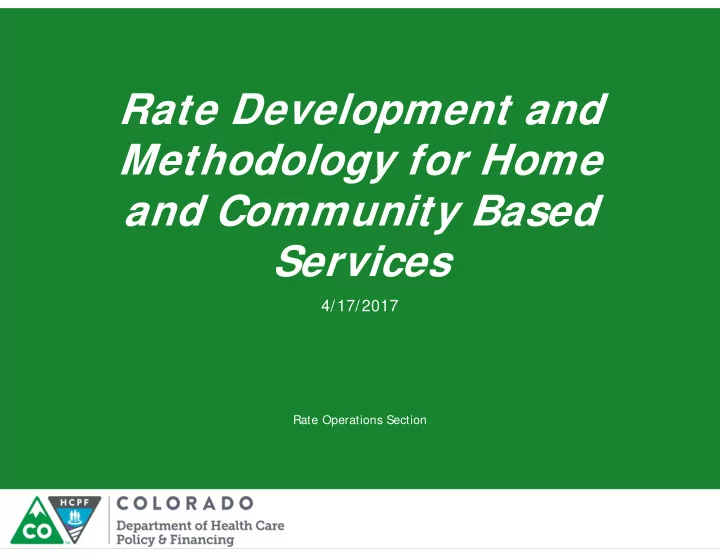

Rate Development and Methodology for Home and Community Based Services 4/17/2017 Rate Operations Section
Our Mission I mproving health care access and outcomes for the people we serve while demonstrating sound stewardship of financial resources
Rate Operations Section The Rate Operation (RO) section develops rate setting methodology and builds rates for several Medicaid services including: 1. Home and Community Based Services 2. Physician, Practitioner, and Specialty Services 3. Free Standing Dialysis Clinic Services
Rate Setting Goals The Rate Operations section has two primary objectives in developing rate setting methodologies and building rates: 1. To reimburse appropriately for Medicaid services using a standardized rate methodology that incorporates all necessary inputs, and 2. To ensure expenditures for Medicaid services do not exceed appropriated funds.
Goal 1: Appropriate Reimbursement • To ensure appropriate reimbursement for services the Rate Operations section utilizes a standardized rate methodology that incorporates inputs necessary to provide services. • The rate methodology is consistent across services and waivers.
HCBS Rate Methodology • The Department has a standardized rate methodology for HCBS rate setting that includes the following categories, each with multiple inputs: 1. Salary Expectation 2. Facility Overhead Expectation 3. Administrative Overhead Expectation 4. Capital Expectation
Salary Expectations • Research and information solicited from providers allow the section to determine: 1. Salaried positions required 2. Staffing Ratios 3. Indirect and Direct Care Hours 4. Full time equivalent of each worker per client • Wages are determined using the Bureau of Labor Statistics Colorado mean wage.
Facility Overhead Expectation • The Department incorporates the following inputs in the Facility Overhead Component of each rate: 1. Property Expenses (Lease and Own) 2. Maintenance for Property 3. Utilities (Gas and Electric) 4. Phone and Internet 5. Miscellaneous
Resources for Facility Overhead Expectation Input Resource Source Property S ize Property Records County Assessor Websites Property Expenses- Real estate market reports for Northern Quantum Commercial Group, Price per S quare foot Colorado, Metro Denver, and S outhern S perry Van Nexx, Colorado Metro Denver Economic Development Corporation Utilities Electric Tariff Index Public S ervice Utility Company of Colorado Phone/ Internet Build Y our Own Bundle Comcast Business S ervices
Administrative & Capital Expectations • The Department incorporates the following inputs in the Administrative Overhead Component of each rate: 1. Annual Software Upgrades 2. Office Supplies • Capital expenses for HCBS services are rare but may include items like a massage table for massage therapy or horses for hippotherapy. • Capital expenses are amortized across the expected life of the supply.
Bringing Components Together Component Per Client Per Unit • The salary expectations are calculated per client for the S alary Expectations $4.50 service Facility Expectations $0.50 • The facility, administrative, and capital overhead Administrative $0.37 expectations are calculated as Expectations an annual/monthly expense Capital Expectations $0.00 and reduced to a per employee cost and multiplied by the required FTE per client Final Determined $5.37 to determine a per client Rate expense
Finalizing the Rate • Once the rate has been built the Rate Operations section completes additional steps to ensure that the rate is appropriate for the service and incorporates the correct inputs by: 1. Performing a comparability analysis across all other states offering similar or identical services, and 2. Completing written documentation of the rate development and all sources utilized in developing the rate
Goal 2: Appropriations • While the Department aims to reimburse appropriately for services we must also ensure reimbursement for services does not exceed the funding appropriated by the Colorado legislature. • To ensure reimbursement does not exceed total appropriations a budget neutrality factor may be applied to the rate.
Budget Neutrality Factor Example: • The final rate for personal care is $5.37 • Funding will only allow for a rate of $4.25 • To ensure reimbursement does not exceed appropriations a budget neutrality factor of 26.35% is applied to the rate • The final rate of reimbursement will be $4.25
Where are stakeholders in the process? • The Rate Operation section incorporates stakeholder feedback into the rate setting process by: 1. Conducting provider surveys on rate setting components 2. Incorporating feedback provided to the Department during committees, meetings and other processes (MPRRAC, TRI) 3. Soliciting feedback, comments, and concerns on the salaried positions, direct/indirect care hours, and inputs included in capital equipment prior to rate finalization
Provider Surveys • Prior to setting rates the Department will send out provider surveys to gain information on: • Required staffing positions, indirect and direct care hours • Facility square feet and number of total employees • Information obtained from provider surveys will inform the rate but must still be validated with additional research • More information and accurate information= better rates!
Soliciting Feedback • Once the rates have been set by Department staff feedback will be requested from stakeholders: Respite-Alternative Care Facility Position Direct Care Indirect Care BLS Mean Wage 79.70 hrs/ month 7.97 hrs/ month $12.59 Home Health Aide (31-1011) 0.00 .25 hrs/ month $54.78 Medical and Health Services Manager (11-1911) Receptionist and 0.00 .125 hrs/ month $14.68 Information Clerk (43-4171) .50 hrs/ month .125 hrs/ month $26.28 Healthcare Social Worker (21-1022) 3.985 hrs/ month .3985 hrs/ mont h $33.65 Registered Nurse
Thank You
Recommend
More recommend